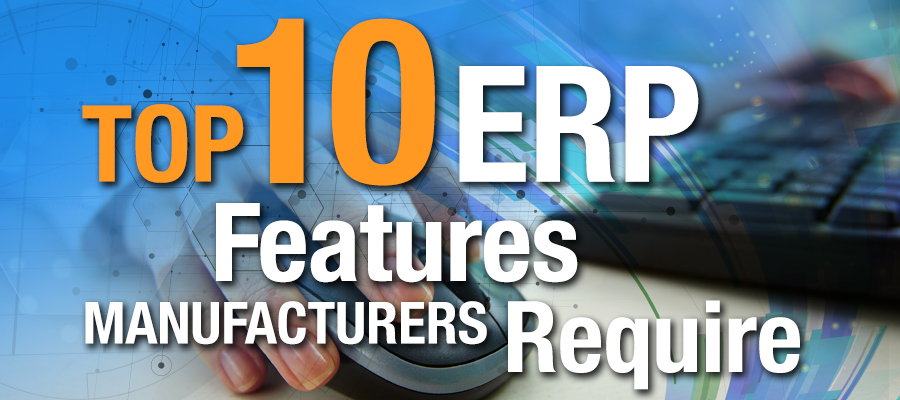It’s easy to list the different software features that live within a typical off-the-shelf Enterprise Resource Planning (ERP) system. However, when it comes to the business complexities of industries like food, beverage, chemical, and pharmaceutical, there are certain functional capabilities that are absolute requirements of being successful.
Here are the 10 most common features and capabilities that we get asked about from manufacturers who are looking to implement a new ERP system.
- Formulation and Quality Control – Batch and process manufacturers may have any number of formulations that they use to create their own products, or the products of others. Proper management of these “recipes” is seen as a crucial first step to successfully running their business. Capabilities like creating workflows for formulation and recipe changes, handling of formula variants (such as those required by certain customers), managing vendor/supplier approvals, and enforcing and tracking quality control checks of received raw materials, are all things to look for in the software you’re considering. Tight control over who can maintain the formulations and make changes is also an important factor – especially when those changes can instantly impact inventory and production planning.
- Production Planning and Scheduling – Accurate and timely planning of a manufacturer’s production processes is another area of focus for many customers looking to new technology. The functions should satisfy both demand-driven and batch scheduling methods that may be used by a manufacturer. Planning typically starts with the bill of materials defining the company’s production requirements, and flows from there. Tie-ins to the master production schedule (MPS), material requirements planning (MRP), and inventory management are all a must-have.
- Lot Tracking – Those manufacturers and distributors doing business in regulated industries must have full visibility and tracking of a product’s lifecycle. This includes everything from the intake of raw materials to the delivery of finished goods to their customers. Full accountability can only be had when all aspects of a business are communicating with each other in a cohesive manner and working in real-time from the same data set. By maintaining true, strict lot control and traceability, researchers in the R&D lab, accountants in the back-office, and crews on the production and warehouse floors have access to 100 percent inventory accuracy. Should a recall occur, the system must be able to generate the proper documentations and provide a full audit trail to remedy the issue and expedite a resolution.
- Warehouse Management – A warehouse management system (WMS) that promotes and enforces tight process controls is proven to drive scalability without the need to increase square footage. Incorporating the latest technologies like GS1-128 barcodes to include GTINs, serial numbers, lot numbers, or even expiration dates, can make processes like cycle counting much more efficient and productive. Operating with a WMS that is an inherent part of the core ERP system creates significant improvements to a manufacturing business like reduced inventory variances, stricter FIFO/FEFO enforcement, and a reduction in picking errors.
- Serialization – Manufacturers of serialized inventory, especially those working within the pharmaceutical or nutraceutical industries, understand the added level of complexity associated with the requirement to assign unique identifiers to products. Among other things, serial numbers help verify legitimacy of products, trace items through the supply chain, and help ensure consistent quality. The ERP software must be able to provide serialization for not only individual units, but do the same for cases and pallets produced without impacting production speed.
- Route Accounting – We often speak with customers whose mobile warehouse operations have grown substantially and cannot be supported by their current paper-based methods of accounting and inventory management. In some cases, a separate direct store delivery (DSD) app is brought in, but manually synching orders and maintaining a different database becomes too burdensome. The route accounting and DSD system should provide distribution capabilities tied to real-time orders, accept electronic signatures, and print customer receipts on site. Ensuring data consistency between drivers and the sales management teams is key to being successful here.
- Mobile Access – As a business expands its operations, the need for mobile ERP very quickly becomes a reality. Access to business information remotely should be as easy as if you were back at the office sitting at your desk. Whether a member of the sales team needs to enter notes after a customer visit, or the production manager needs to review the latest purchase order of raw materials, the mobile ERP should utilize the same set of business logic and provide as much real-time visibility to data as the main application. Manufacturers shouldn’t settle for a mobile option that limits the level of data and insight that can be accessed. The same level of insight should be available across every device.
- Maintenance, Repair, and Operations (MRO) – For manufacturers, keeping their equipment running smoothly is just as important as the products they produce. MRO tools can help forecast spending, keep production disruptions at bay, and reduce the impact of unexpected issues. An MRO system built directly into the ERP can use the centralized data source to assign maintenance task priorities, report on job details, and track hourly equipment running costs, among other things.
- Document Generation – Whether it’s creating a Safety Data Sheet, printing Nutrition Fact labels, or generating Certificate of Analysis (COA) documents, the information for all of these documents should come from a centralized location. Manually creating them is not sustainable for a growing business, nor is it always accurate – especially risky for those working within a regulated space. A COA document, for example, should automatically include QC test results of materials used in the manufacturing process, and include all of the customer required data points. This should be done without any required input from the individual responsible for the putting the shipment together.
- Reporting – At the end of the day, it’s all about making quicker and better business decisions. Consolidated reports from multiple facilities, current or forecasted production performance, and formula revisions are a few of the details that manufacturers deem necessary to be strategic. The ERP system needs to be capable of providing flexible dashboards tailored to the user, department, or even facility, and pull in real-time information from across the entire enterprise. Full operational insight can be achieved when these reports are part of the core system as it allows for a better understanding of performance and areas for improvement.
All too often we see instances of manufacturers with multiple disparate systems incapable of updating to newer versions, yet these are used to run a business. This distorted ERP environment leads to scalability hindrances, lost productivity, and negatively impacted revenue.
The 10 most common manufacturing software requests listed above are all part of Deacom’s comprehensive ERP platform. With the industry’s largest functional footprint, we provide manufacturers and distributors with an optimized approach to meeting their critical business needs.
So, what are your most desirable ERP capabilities? We want to hear from you! Send us a note to marketing@deacom.com and let us know your opinion.

